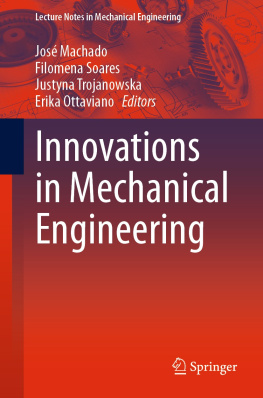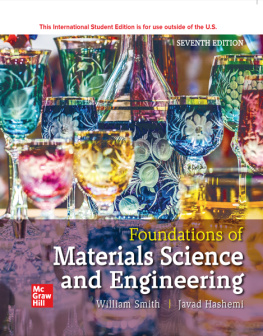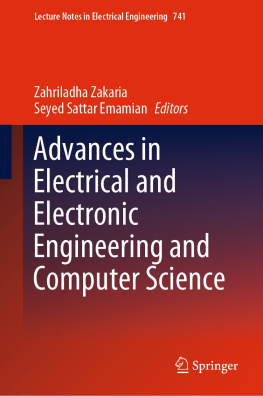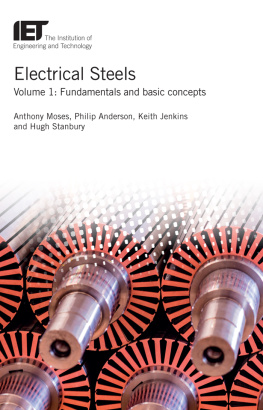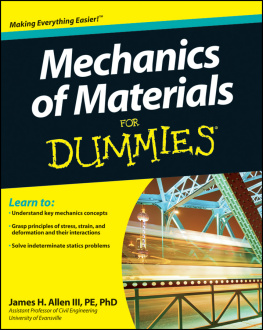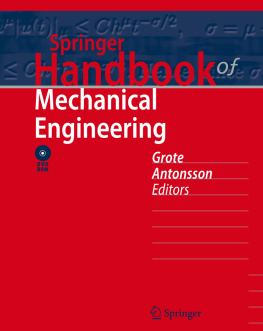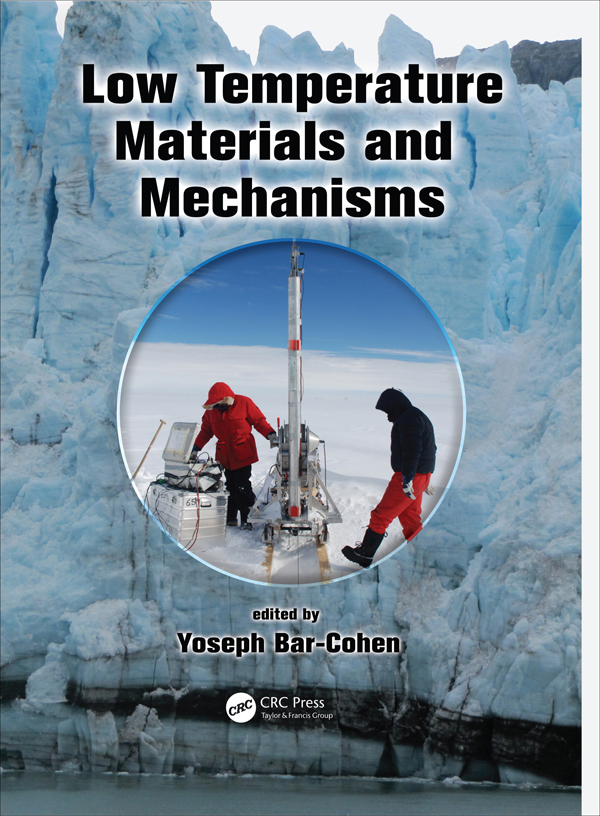
Low Temperature
Materials and
Mechanisms
edited by
Yoseph Bar-Cohen

Contents
Landmarks
Low Temperature
Materials and
Mechanisms
CRC Press
Taylor & Francis Group
6000 Broken Sound Parkway NW, Suite 300
Boca Raton, FL 33487-2742
2016 by Taylor & Francis Group, LLC
CRC Press is an imprint of Taylor & Francis Group, an Informa business
No claim to original U.S. Government works
Printed on acid-free paper
Version Date: 20160504
International Standard Book Number-13: 978-1-4987-0038-2 (Hardback)
This book contains information obtained from authentic and highly regarded sources. Reasonable efforts have been made to publish reliable data and information, but the author and publisher cannot assume responsibility for the validity of all materials or the consequences of their use. The authors and publishers have attempted to trace the copyright holders of all material reproduced in this publication and apologize to copyright holders if permission to publish in this form has not been obtained. If any copyright material has not been acknowledged please write and let us know so we may rectify in any future reprint.
Except as permitted under U.S. Copyright Law, no part of this book may be reprinted, reproduced, transmitted, or utilized in any form by any electronic, mechanical, or other means, now known or hereafter invented, including photocopying, microfilming, and recording, or in any information storage or retrieval system, without written permission from the publishers.
For permission to photocopy or use material electronically from this work, please access www.copyright.com (http://www.copyright.com/) or contact the Copyright Clearance Center, Inc. (CCC), 222 Rosewood Drive, Danvers, MA 01923, 978-750-8400. CCC is a not-for-profit organization that provides licenses and registration for a variety of users. For organizations that have been granted a photocopy license by the CCC, a separate system of payment has been arranged.
Trademark Notice: Product or corporate names may be trademarks or registered trademarks, and are used only for identification and explanation without intent to infringe.
Library of Congress Cataloging-in-Publication Data
Names: Bar-Cohen, Yoseph, editor.
Title: Low temperature materials and mechanisms / editor, Yosef Bar-Cohen. Description: Boca Raton : Taylor & Francis, a CRC title, part of the Taylor & Francis imprint, a member of the Taylor & Francis Group, the academic division of T&F Informa, plc, [2016] | Includes bibliographical references and index.
Identifiers: LCCN 2016000772 | ISBN 9781498700382 (alk. paper)
Subjects: LCSH: Materials at low temperatures. | Machinery--Effect of environment on. | Low temperature engineering.
Classification: LCC TA418.28 .L69 2016 | DDC 621.5/6--dc23 LC record available at http://lccn.loc.gov/2016000772
Visit the Taylor & Francis Web site at
http://www.taylorandfrancis.com
and the CRC Press Web site at
http://www.crcpress.com
Operating at cold temperatures is essential to many science and engineering processes including refrigeration, space exploration, electronics, physics, chemistry, thermodynamics, and medicine. For thousands of years, humans have used temperatures near the freezing point of water and taken advantage of the resulting benefits. Over the last two centuries, it has become feasible to reach cryogenic temperatures as a result of the development of effective coolers. The production of cryogenic temperatures involves several challenges and disadvantages and, to be useful or marketable, applications need to have benefits that outweigh the disadvantages.
Generally, cryogenics is the science and engineering of creating and investigating low-temperature conditions. The word cryogenics is derived from the Greek words kryos, meaning frost or cold, and genic, meaning to produce. Until around the mid-eighteenth century, it was believed that some gases could not be liquefied and were named permanent gases. These gases were carbon monoxide, hydrogen, methane, nitric oxide, nitrogen, and oxygen, with the most attention given to the primary constituents of airoxygen and nitrogen. While cold temperatures can include temperatures at the level of water freezing (0C), the term cryogenic environment refers to the temperature range below the point at which the permanent gases begin to liquefy. The term was applied initially to temperatures from approximately 100C (148F) down to absolute zero Kelvin, and today the definition refers to temperatures below approximately 150C (238F). In 1894, Kamerlingh Onnes, of the University of Leiden, Netherlands, was the first to coin the term cryogenics as the science of producing very low temperatures to liquefy the gases that were considered permanent. The English physicist Michael Faraday was one of the most successful in liquefying permanent gases; by 1845, he had managed to liquefy most of the permanent gases known at that time. He liquefied the gases by cooling them via immersion in a bath of ether and dry ice and then pressurizing until they reached the liquid state. The liquefaction of air was accomplished in 1877 by Louis Cailletet in France and by Raoul Pictet in Switzerland. In 1898, the liquefaction of hydrogen was successfully accomplished by the Scottish chemist James Dewar. In 1908, the last remaining gas element, helium, was successfully liquefied at 4.2 K by the Nobel laureate Dutch physicist Heike Kamerlingh Onnes.
Increasingly, there is a growing interest in technologies that are applicable at low temperatures for planetary exploration of bodies in the solar system that are extremely cold. These include potential NASA in situ exploration missions to Europa and Titan where the ambient temperatures are around 200C. Elsewhere, as a method of slowing or halting chemical and biological processes, cooling is widely used to preserve food and chemicals, as well as biological tissues, organs, and embryos. Furthermore, cooling is used to increase electrical conductivity, leading to superconductors that enable such applications as levitation, highly efficient electromagnets, etc. The subject of low temperature materials and mechanisms is multidisciplinary and includes chemistry, material science, electrical engineering, mechanical engineering, metallurgy, and physics.
The temperature scale that is based on absolute zero with units in the same size as the Celsius degree is known as units Kelvin and is abbreviated as K. This symbol of the Kelvin unit was adopted in 1968. In the absolute, or Kelvin, scale, the lowest temperature is written as 0 K (without a degree sign). The Rankine scale with the symbol R represents the English absolute scale and has the same unit increments as the Fahrenheit scale.
The temperature of a material is a measure of the energy that it contains, which occurs in various forms of motion among the atoms or molecules that make up the material. A gas with a lower temperature has slower-moving atoms and molecules than gases at higher temperatures do. The possibility that a material can have a state at which all forms of motion are halted was predicted in 1848 by the English physicist William Thomson, later known as Lord Kelvin. The absence of all forms of motion would result in a complete absence of heat and temperature; this condition was defined by Thomson as absolute zero, which is equal to 273.15C (459.67F). With the advent of quantum mechanics in the early twentieth century, we now know that at absolute zero some atomic motion and energy still exists in materials, but it is in the lowest possible energy state, known as the ground state. Much of low temperature physics involves the study of materials close to the ground state where unusual behavior can occur.
Next page

